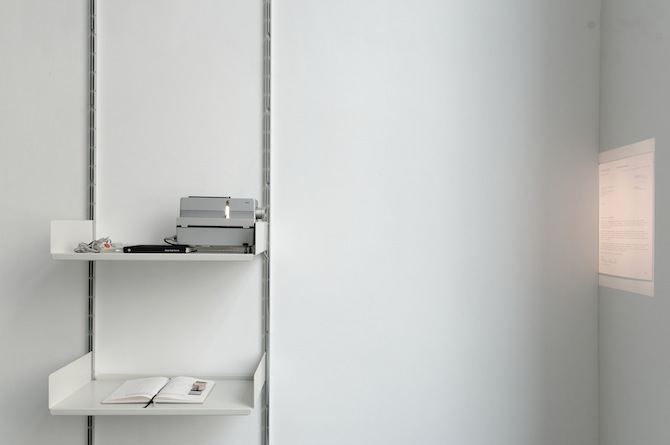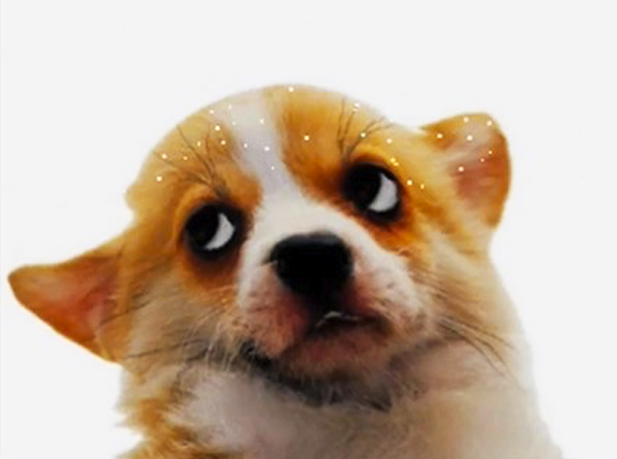BLOG
Courtesy of the Artist and Seventeen, London; Zach Feuer, New York; Future Gallery, Berlin
MEET
Montreal-based artist
Jon Rafman
July 15 2013
1:36 PM
The Canadian artist Jon Rafman has established a reputation as a digital flâneur, replacing the city street with the glare of a Macbook screen. His far ranging projects have seen him give guided tours on Second Life as the Kool-Aid Man, and wrap modern art around the contours of digitally rendered corporate interiors—a bit-mapped Juan Gris painting becomes wallpaper, carpet, ceiling and furniture. Recently, in collaboration with Rosa Aiello he has tackled the essay film in Remember Carthage (2013), bringing together footage from video games with a narrative that combines fact and fantasy in the guise of a historical voyage. The notion of the travelogue is central to Rafman’s most famous work, Nine Eyes of Google Street View (2009-ongoing). The artist tirelessly searches Google street view, capturing images with particular resonance. Rafman replaces his Leica for a laptop, and in doing so he updates the historical model of street photography. Like Jeff Wall on a budget, he has an eye for the surreal, the images are full of absurd and grizzly details: an armed man, an escaped lion and the aftermath of a hit and run. Recent exhibitions at the New Museum and Palais de Tokyo testify to the artist’s growing stature. Jon Rafman has a current solo exhibition at Seventeen gallery in London: an excellent opportunity to take a closer look at this constantly inventive artist. (George Vasey)
Jon Rafman’s solo exhibition “A Man Digging” at Seventeen gallery, London, will run through July 27.
Courtesy of Dan Graham
FOLLOW
Manchester International Festival
July 3 2013
6:08 PM
The Manchester International Festival was established in 2007 and this year marks its fourth edition. Counter to most biennials MIF does not offer a singular curatorial perspective, but rather an eclectic program of new international commissions in the visual arts, theater and music. Previous years have seen pivotal commissions from figures as diverse as Gustav Metzger, Damon Albarn and Marina Abramović among many others. This year’s festival brings a similarly eclectic selection of new work from international artists. Highlights include a collaboration between one of the UK’s most restless pop musicians, Massive Attack’s Robert Del Naja, and a consistently experimental documentary filmmaker, Adam Curtis, to “redefine the notion of the gig.” Hans Ulrich Obrist will return to Manchester (after co-curating “Il Tempo del Postino” in 2007) to co-curate his ongoing “Do It” project alongside Christian Boltanski and Bertrand Lavier. Other highlights include This Variation, the UK premiere of Tino Sehgal’s much-acclaimed Documenta project from last year. The XX (the soundtrack to every arty party) will be in residence playing in a specially designed 60-capacity room—a perfect setting for their economic and intimate music. Manchester International Festival will be held this summer between the 4th and 21st of July. (George Vasey)

Courtesy Le Musée des Erreurs
VISIT
“Sainte-Victoire. Corporate Identity”
at Galerie de l’erg, Brussels
May 24 2013
3:33 PM
“Sainte-Victoire. Corporate Identity” is the first exhibition presented by Le Musée des Erreurs, a project instigated by Pierre Leguillon. Held at Galerie de l’erg, the exhibition brings together an eclectic ensemble of artworks and objects from diverse figures such as Dieter Rams, Richard Hamilton, and Simon Starling. It narrates Richard Hamiltonʼs admiration of the designer Dieter Rams through a selection of objects and images collected by the designer Jules Wabbes. The title references a letter that Hamilton wrote in 1980 citing Dieter Ramsʼ influential tenure at the design company Braun. Hamilton draws parallels between the “crystalline” form of Cézanneʼs paintings of Mont Sainte-Victoire and the prodigious design genius of Rams. In his practice over the last twenty years, Leguillon has engaged with a form of art world cryptology. His work, often performative, has seen him adopt the position of curator, critic, and lecturer, and includes the various excavations of figures such as Josef Albers, John Baldessari, Ad Reinhardt and Diane Arbus. This new exhibition picks up on the artist’s previous projects probing the economy of objects and images within circuits of display and distribution. He is interested in the infidelity of ideas, often open-sourced and migrating between the worlds of art and design. “Sainte-Victoire” amplifies these shifts and appropriations, attempting to trace their genealogies and intricate narratives. (George Vasey)
The exhibition “Sainte-Victoire. Corporate Identity” at Galerie de l’erg will run through June 14.
Courtesy of the artist; Vilma Gold, London
VISIT
Julia Wachtel’s exhibition
at Vilma Gold, London
March 18 2013
3:20 PM
Active since the early 80s, the American artist Julia Wachtel has gained international visibility, yet her work remains curiously under-presented in the UK. Her new solo exhibition at Vilma Gold will be her first in the UK. Typically, Wachtel combines oil painting with screenprinted material that is often augmented with blocks of flat chromatic colour. Familiar imagery such as cartoons, commercial branding, and televisual images are placed next to more political and socially-conscious iconography. Wachtel deploys an array of editing technique: including, cropping, repetition, and shifts in scale to modify the original material. Emerging in the early 80’s alongside figures such as Richard Prince and Robert Longo, Wachtel absorbed many of the appropriation strategies of the era. Where many ‘Pictures Generation’ artists seem stuck in a time warp, Wachtel’s work seems particularly current. There is an oblique narrativity to the new work that strikes a cord with younger artists perhaps less concerned with deconstructive debates around the death of the author. Appropriating and remixing content is now pervasive in an era of the ‘post-internet’, it has lost much of its original subversive intent. Yet, Wachtel yields unexpected affiliations, anchoring her interests in mass culture with broader formal concerns. With her recent inclusion in the ICA‘s “Remote Control” exhibition, her new solo exhibition at Vilma Gold offers a timely opportunity to appraise first-hand the work of a consistently inventive artist. (George Vasey)
Julia Wachtel’s exhibition «Post Culture» at Vilma Gold, London, will run until 27 April.

Courtesy of the artist and Gloria Maria Gallery, Milan
MEET
California based artist
Petra Cortright
December 20 2012
11:29 AM
The young American artist Petra Cortright makes gifs, jpegs, digital videos and prints that incorporate a profusion of kitsch imagery. Her work has a magpie sensibility that is attuned to the conditions of our networked environment. She is what Marc Prensky would term a “digital native”—an artist who is fluent in HTML and at home among hyperlinks. Typically, Cortright films herself enacting slight, repetitive gestures in front of a webcam, which are then overlaid with cheap digital FX. The face is often obfuscated through layers of effects, burying the artist’s identity and blurring the space between the body and environment.
Born out of what seems like an excess of time and content, there’s something narcotic about Cortright’s work. Time accelerates and slows down; it is a world where not much happens and yet everything loops over and over. There is a pervasive attempt to reinscribe the body through forms of self-representation (albeit heavily masked), as seen, say, in her recent painterly Photoshop images. Her work, like many of her peers, belongs equally online and in galleries. She pushes the technology against itself, revealing its fractures and glitches.
Cortright’s work is full of what Paul Virilio calls “Picnolepsy,” or little “epileptic lapses in concentration.” It is a bodily response to the velocity of modern life that is both dissociative and disorientating. In these loops and glitches you can see Cortright’s response to an environment where the space between production, consumption and dissemination is collapsed—a world where our lives dissolve into the computer screen, a perfect immixture of the real and the virtual. (George Vasey)
Petra Cortright will have a solo show at Gloria Maria Gallery, Milan in January
Courtesy of the artist and Rod Barton, London
VISIT
Gabriele Beveridge
at Rod Barton, London
November 19 2012
3:23 PM
“Newly Laundered Smile” is a great title for an exhibition. To ‘launder’ is an idiomatic phrase that can mean both to clean and conceal. It suggests elaborate fiscal scams and laundromats, an image that perfectly captures the tone of Gabriele Beveridge’s new solo exhibition at Rod Barton. The work in the exhibition brings together a number of assemblages that include appropriated content from vintage magazines and advertising – the work is populated by beautiful models and far away places. The images are placed within a highly attuned constellation of materials including plants, cigarettes, ametyst mineral, lipstick and an old Nikon camera.
It is useful to think about Beveridge’s methods as akin to that of the filmic edit - specifically, the dissolve and close-up. A faded portrait of a female model whose smile was once used to sell sun cream and the high life now stares back at us blankly, the truncated image removed from its own genealogy. The cinematic dissolve (the screen fades to white in the edit) suggests time lapsing or a dream sequence.
The allusions to reverie seem apt, and the work is marked by a hyper sensitivity to materiality and display that feels almost dream like. The filmic close-up for Giles Deleuze is an ‘affection-image,’ cutting the face off from time and concealing it from a context – in its place we project our own desires and narratives. “Newly Laundered Smile” is about that moment where time stands still. Where the ceaseless flow of images gets stuck, it feels like a film without beginning and end only a perpetual middle. (George Vasey)
Courtesy of Rob Tufnell
TOP 10 SUMMER SHOWS
Rank 2: “Panem et Circenses”
at Rob Tufnell, London
August 8 2012
7:23 AM
As Olympic mania crescendos in London, sport-themed summer exhibitions are legion. Featuring historical and contemporary works by a disparate group of artists, “Panem Et Circenses” (Bread and Games) offers a timely riposte to the games motto, “Inspiring a generation.” Guy Debord’s film Society of the Spectacle (1967) sets the tone for “Panem Et Circenses,” an exhibition of works that explore strategies of negation.
Elsewhere, Michel Auder’s The Games: Olympic Variations (1984) appropriates TV footage of Olympic athletes, but changes the way it is edited together in order to create elliptical sequence that challenges the way we read the images. Oliver Laric’s KopienKritik (2011) a resin cast of Hercules’s head riffs on the Roman tradition of remaking Greek sculpture. Both artists’ transgression of copyright law are a pertinent response to the corporate lockdown of the London Olympics. To accompany the exhibition, Tufnell has republished Paul Lafargue’s The Right to be Lazy. Originally published in 1883 the essay advocates a resistance to the “dogma of overwork.” A timely reminder that to stop competing can sometimes be the only radical gesture left. The athletic body offers an obedient repository for late capitalism, in contrast with the myriad disobedient bodies currently striking, rioting and occupying spaces in cities the world over. (George Vasey)






